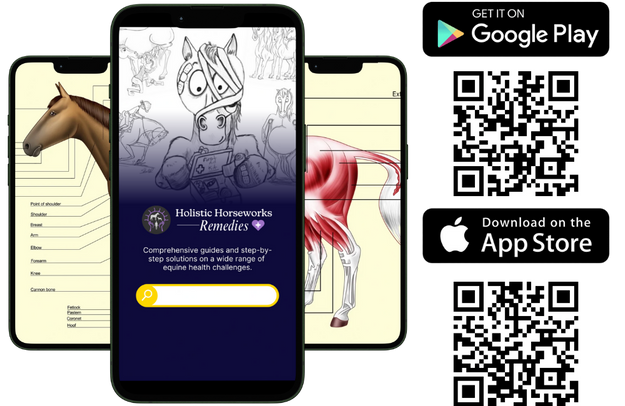Is your horse tripping or short striding? Do you wonder why your horse is pinning ears, swishing tail when saddled or when being asked for the trot or canter? A horse unwilling to flex at the poll, bend to the bit, unwilling to extend the gait, canter on the other lead or stop quickly, turns better to one side than the other – these are all signs the horse’s body has restriction of motion somewhere and is unable to do what we ask of them. Continual repetitive motion exercises like lunging or working a certain pattern can create mysterious lameness as well as pre mature arthritic conditions like sidebone, ringbone, arthritic knees and hocks. Another arthritic condition is called ‘Kissing Spine’ which is easily fixable! When you know what the cause is and what the body needs to come back to fluid way of moving anything is possible!
I can help you find the issue and what the horse needs to resolve it with yoga exercises so you can have a well-rounded, light on the bit, collected horse with smooth gaits and transitions that can become a fun and willing equine partner. I have DVD’s to teach you how to do the work as well as ‘Distance readings’ to dial down on your horses specific issues on my website.
These simple yoga stretches for horses will help you identify where the problem area is and help the horse work it out. If your horse is unable do these exercises easily, please call me for help as there are deeper issues to resolve that will shorten their riding years.
Let’s take a closer look. If you see a little dip before the withers you have a lack of muscling right in that area, which means you don’t have free use of the front end. When you look down the front end to the hooves, you will see where the horse won’t actually square up in the front naturally. If they are always standing with one foot ahead of the other, you have something going on that’s uncomfortable deep under the withers. Standing like this will create the High-low syndrome in the hooves the farriers are always working on.
CARROT STRETCH
Move along the back towards the croup and if you see a raised backbone, where the saddle ends, that tells you the back muscle is shorter and in spasm. We’ve all had a muscle spasm yes? It can be very painful and tightens that area to not be able to move freely. The muscle shortens and grabs the pelvis and tilts it. This restricts freedom and gives you a horse that is unable to comfortably square up in the hind end, meaning both hind hooves side by side. Also when your lower back is in spasm you cannot walk up or down hills comfortably or correctly yes? Same with our horses!
Use a carrot to get your horse to stretch and reach back. Your goal is to have your horse go all the way back to the stifle (rear knee) and hold the stretch for as long as it can. If they can only reach half way, you know they’re really tight down the shoulder. Practice this with your horse every day until they can reach all the way back.
If they are doing a lot of head tilting to the left or right during the carrot stretch this means that the atlas and axis are not in perfect alignment. This will give you a horse that cannot flex at the poll to be light on the bit. If one side stretch seems to go way further than the other, then there could be something deep in the shoulder created by first rib not being where it should be, not allowing the shoulder to move freely.
LEG STRETCH
The next exercise I’m going to show you helps to stretch the ribs, shoulder, scapula and wither areas. Gently pick up your horses’ leg and stretch it forward holding it behind the knee. Lift up and in across the horses chest circular stretches to get to the area in the ribs that’s tight.
After the up and in big slow leg circles you want them to stand on the other leg and not put any pressure on the leg you are holding as you ease it down and across the other leg. I’m just holding by the pastern lightly then asking to put hoof on the ground. We call this ‘drunken horse pose’. You should be able to keep her here for a minimum of sixty seconds and it should be comfortable to the horse.
TAIL PULL
Now we’ll work on freeing the hind end. I like to start with the tail pull, which tractions the hind area, and you want to do it for a minimum of two minutes. You want the horse to be squaring up, so start with a gentle pulling pressure until they’re ready for it and they pull back against you. Before you begin, make sure that your horse is safe to stand behind. With the tail following the same angle that it comes off the croup, you want to make sure that the horse is squared off in the hind and they don’t have one foot more in front than the other.
While I hold on to the end of the tail, I’m just going to be gently rocking her from side to side until she decides to move. She will then square up and spread her hind legs. You may notice that her feet are more far apart and she’s ready for me to give her the traction. Remember this is going to be a minimum of two minutes so don’t let go too quickly. You want to make sure when you let go that you come up gradually.
STRETCHING THE LOWER LUMBAR AND MUSCLES
This exercise is what stretches out the lower lumbar and muscles that are tight and in spasm. We are going to bring up the pelvis and buttocks. As with the tail pull exercise, be sure that your horse is safe to stand behind. You want to teach her to roll their hind end under, which is what they are going to need to be able to do to collect and free up the lower back area. So about five to seven inches out from the top of the tail where you’ll find a little hard spot. You’ll scratch and push just looking for a little movement and hold for a count of ten. You want to do this for at least 2 min asking for a little more and then holding for a count of ten. If they are moving away from you then you’re going too fast for their body unwinding.
Just hold with pressure and do this until you can roll her up almost to the withers. You’re going to ask her for a little and hold, I like to count to ten. Then ask for a little more and hold, you’re going to keep asking and as you’ll notice her lower back is starting to raise and her rear ribs are starting to rise. When you’re doing this, make sure you keep her spine straight to the withers. If they are dipping down to one side you’re going to be pushing a little hard on that side. What you’re looking for is all of the ribs near the hip area to lift all the way up.
BELLY LIFTS
So after you’ve done all their front leg stretches, tail pulls, and buttocks you will do belly lifts. Place your hands under their girth area and scratch with your finger nails to lift then hold still with firm pressure to hold the back up. If they cannot do this then all the ribs are not where they should be to support your saddle tree, and their topline will drop, looking like an old horse. This will create saddle fitting issues! What you can do is bring her belly up and hold with pressure. I’m going to do the same series of five where I count for ten seconds, ask for a little bit more and hold with pressure. There’s no reason for a horse’s top line to drop, the back needs to come up and support you so the front end and hind can move freely
I created this diagnostic yoga for horses video so more horse owners will get involved with understanding how their horse should be able to move, and if done daily you will have a different horse in just 30 days. If they cannot easily do these moves in 5 min they you have deeper glitches needing a ‘Distance reading’ and my Home Study DVD course to teach you how to fix it yourself.


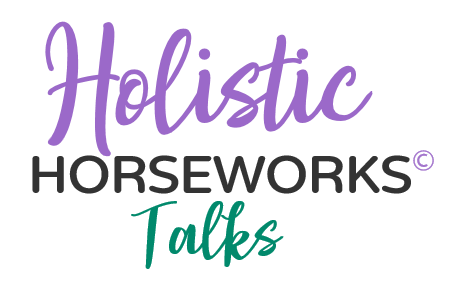
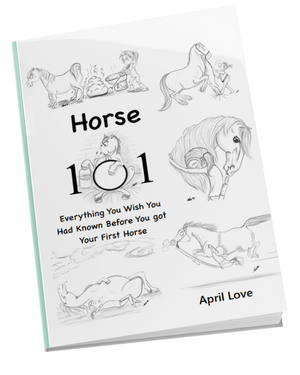
![Complete Level 1 & Level 2 Home Study + Private Training Package [NO DVD]](https://holistichorseworks.com/wp-content/uploads/2022/08/Level-1-and-Level-2-complete-home-study-and-training-package-400x400.jpg)
![Level 1 "Equine Musculoskeletal Unwinding" Home Study -Watch Instantly [NO DVD]](https://holistichorseworks.com/wp-content/uploads/2022/08/Level-1-Home-Study-400x400.jpg)
![Level 2 “CranioSacral Unwinding & Advanced Applied Kinesiology” Home Study - Watch Instantly [NO DVD]](https://holistichorseworks.com/wp-content/uploads/2022/08/Level-2-Home-Study-400x400.jpg)
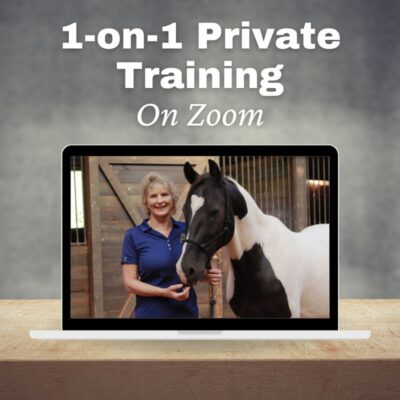
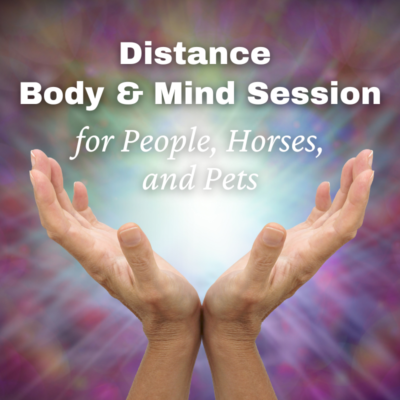
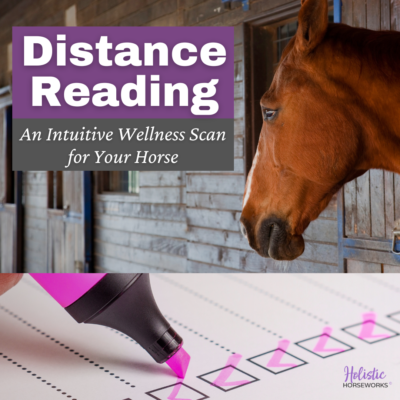
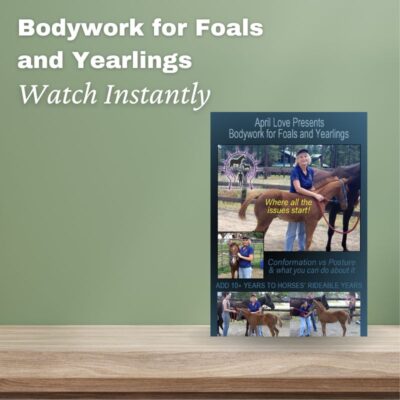
![Equine CranioSacral Energy Work -Watch Instantly [English and French]](https://holistichorseworks.com/wp-content/uploads/2022/09/equine-cranial-sacral-energy-work-watch-instantly-400x400.jpg)
